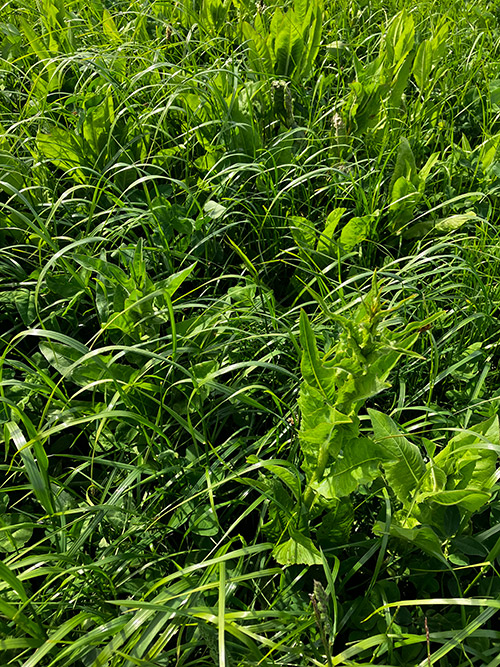
With the new sustainable incentive scheme paying £382/ha for planting multi-species leys (MSLs), interest in them is growing rapidly but livestock producers need to consider carefully their fit into existing forage systems, says Agrii agronomist Mark Smyth.
While there are many benefits, including increased biodiversity and better soil health, MSLs require a different management regime to that for a typical ryegrass sward if the benefits of the various species in mixes are to be maximised, he says.
“MSLs are generally made up of grass, legumes and herb species which together create a more diverse forage with greater resilience to climatic extremes as well as contributing significantly to soil structure and fertility.
“Because they’re rooting at different depths within the soil profile with many species, such as Chicory and Plantain, being especially deep-rooted, they’re extremely effective at breaking up compaction.
“Then there are leguminous plants such as Sanfoin and Clover which actively fix nitrogen to make it available in the soil.
“Others can boost livestock health due to their ability to extract minerals from the soil, particularly Chicory, Plantain, Sheep’s Parsley and Burnet, due to their deep rooting nature, and this also helps with growth during dry periods.
“Chicory and Sainfoin also have a natural worming element as they have anthelmintic properties and this can be extremely valuable in some circumstances.”
Time of planting important
Those tempted by the £382/ha SFI payment have 12 months from signing up to putting their MSLs in and timing needs some thought, Mark Smyth advises.
“When establishing a full reseed MSL with grass, spring or autumn planting is fine, but if overseeding it becomes more challenging in the spring as seed to soil contact is key and the minimum soil temperature must have reached 8-10oC before considering planting.
“August/September is, therefore, often the better timing for overseeding due to less grass and weed competition, however if considering spring it’s important to lightly graze afterwards to ensure the new seedlings don’t get smothered out.”
Rapidly growing species in mixes, such as Chicory, also need consideration, he adds.
“These will need frequent grazing and should only really be considered for silage-making in a multi cut system, where frequent cutting will stop them becoming overgrown and producing more fibre which could result in lower D Value silage.
“Managed correctly, MSLs can provide a nutrient-rich home grown forage with significant environmental benefits, underpinned by a healthy incentive from the lates SFI scheme for their use.”
Multi species leys impress on North Devon farm
Now entering his third year of using multi-species leys for fattening over 900 lambs/year, North Devon livestock producer Mike Bellew has gained valuable insight into how to get the best from them.

“It’s very much a learning curve. You need to adopt a different mindset from that needed for grassland, but the lambs have definitely done well on them and management is relatively straightforward,” says Mike, who farms in partnership with his wife Gill and daughter Helen.
“Plus, of course, there is the financial incentive to use them to factor in which, when we drilled them was under the mid-tier of the countryside stewardship scheme, but in the future will be included in the new sustainable farming incentive (SFI) arrangements.
“So, all in all, there are some pretty compelling reasons to start looking at them, whether it’s from economic, practical or environmental viewpoints.”
With 500 breeding ewes, 100 head of cattle to finish each year and 80ha (200 acres) of arable production, Gammaton Barford Farm, near Bideford, is a true mixed farm, Mike explains.
“We grow wheat, barley, oats and potatoes alongside the livestock operation and the aim is to lamb our mainly Mule-based flock in one block in the middle of March.
“The plan is then to wean early and get the lambs out on the herbal leys as soon as we can and they’re then sold between the following September and January the next year.
“The Belgian Blue cross Friesians we rear are fattened over a two-year period and only go out on to grass for the second summer only, so most of our experience of herbal leys so far has been with the sheep.
“On the advice of Agrii agronomist Mark Smyth, who advises on all our crops, we decided to try 12ha of multi-species leys to see how we might get on with them and this area was drilled in Autumn 2021.
“We decided to take a similar approach to drilling and establishment as we would grassland, with ploughing followed by a combination drill and then rolling.
“One of the fields was permanent pasture beforehand and the other was on arable land. The one that was previously arable stayed clean throughout, but the one drilled on the land that was grass, has given us some challenging weed problems.
“We’ve had thistles, docks and everything but have to be very careful how we manage these. Herbicides are largely out if we want to hang on to the chicory, clover and other species in the new ley, so it’s been a question of topping and keeping on top of things.”
Best management options
Observations around how drilling date affects germination and establishment have also been made, he says.
“We managed to get the first field drilled in the third week of August but had to wait until 10th September for the second one and the species with the smaller seeds, such as chicory and plantain, definitely struggled to germinate in the later position.
“You definitely have to be careful with them in the early days, especially that first winter. We decided to let the sheep lightly graze the earlier sown ley through the winter but kept them off the later one until the following spring.
“We’ve found strip grazing works reasonably well with multi-species leys, but it’s not ideal, so we’re going to be looking at a rotational grazing approach this season. I think that will be more effective.
“One of the issues you have to work around, is that the nature of the ley changes constantly through the year because of the number of species that make up the mix all growing and maturing at different rates.
“But equally, that gives them a fair degree of resilience and ability to cope with varying growing conditions. Regardless of conditions, something seems to be growing well whatever the time of year.
“The clover, for example, took a fair time to establish initially but by the May after drilling it was well away. When the weather turned dry after that, it was one of the plants that stayed green the longest as it had put down the strongest roots.
“It’s done equally well in the wetter conditions we experienced in 2023, so that diversity of species genuinely gives them built-in resilience.”
That said, multi-species leys do need treating with respect if you’re going to get the best from them, Mike Bellew points out.
“It’s not a good idea to graze them too tightly. They’ll also suffer if you leave the sheep on them too long and graze them right down.
“With a bit of care, I am sure they will remain productive for the five years required under the existing stewardship agreement and I’ll certainly be looking to put more in over the next few years under the new SFI scheme.”


